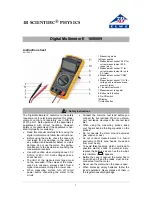
3 • FACEPLATE DESCRIPTION
4 • CONNECTIONS
INPUTS
INPUT 1:
Digital input from mechanical contact or logic signal
between terminals
1 and 2 with following functions:
- Timer Start/Stop
- Counter input pulses.
- Frequency meter input pulses.
INPUT 2: Digital input from mechanical contact or logic signal between terminals
1 and 3 with following functions:
- Timer reset
- Counter reset
- Frequency meter reset
INPUT 3: Digital input from mechanical contact or logic signal between terminals
1 and 4 with following functions:
- Timer hold or up/down
- Counter hold or up/down
- Frequency meter hold
Sensor power supply to terminals 5(+) and 1(-): 12V/30mA.
OUTPUTS
- Logic (NPN) or relay (5A/220Vac) output;
- Available to terminals 8 (NO contact), 7 (common) and 6 (NC contact);
terminals 6 (+) and 7 (-) for logic output.
Power supply: AC Voltage is applied to terminals 9 and 10 (110/220V selected
with jumpers).
Voltages available on request: 24/48Vac - 120/240Vac - 110/220Vac - 24Vcc
With 24 Vdc, polarity is not critical. See Hardware Configuration.
A Display
Real value of current time/count/frequency. The real value is the value of the time/
count active at that time:
Time 1 (count 1) or Time 2 (count 2). Symbol of parameter set on display B during
configuration.
The decimal point on the right indicates display of Time 2 (count 2).
The appearance of the EEP message indicates an EEPROM memory fault.
B Display
Setpoint value of time/count/frequency selected.
These parameters can be set during configuration.
The decimal point on the right indicates display of set 2.
F LED signals
I1 : State of IN1 input signal.
Start/Stop in case of timer
Clock in case of counter and frequency meter
I2 : State of IN2 input signal in case of timer and frequency meter; IN3 in case of
counter;
- LED off, corresponds to input OFF
- LED on, corresponds to input ON
O : State of output relay (LED on = relay energized) - OUT.
CONTROLS
C “FUNCTION” button
Accesses display/setting of Time 2 (count 2) setpoint or hysteresis for type U4
frequency meter [see Description of Operation] (decimal point flashes on right
display).
If the F button is not pushed to confirm a change, the new value will be stored
automatically after 5 seconds.
Push the F button for 5 seconds to access the configuration phase. Scroll the
functions to be set by means of short pulses.
To quit configuration, push the F button again for 5 seconds.
NOTE: It is not necessary to press the F key to display/modify Time 1/Count 1.
E/D Raise (E) and Lower (D) buttons
These are used to raise or lower the value shown on display B in order to change
a setting or choose an option.
The speed of raising (lowering) is proportional to the time for which the key is
pressed. The operation is not cyclical.
If the automatic scale change is enabled, once the maximum (minimum) value of
any intermediate scale is reached, the raise (lower) function moves to the next
(previous) scale.
In normal operation, these buttons can be used for direct change of Time 1/Count
1 (setpoint).
E
F
A
B
D C
NC
C
NO
COM
IN1
IN2
IN3
+12Vdc
sensor
POWER SUPPLY
OUT1
(MAIN)
2
80469C_MHW_556_02-2011_ENG

























